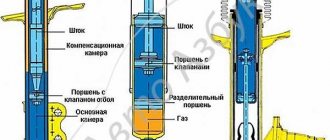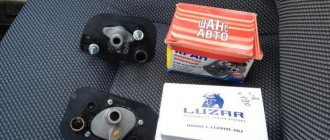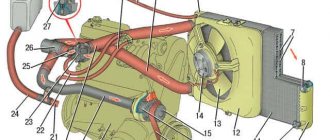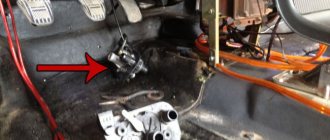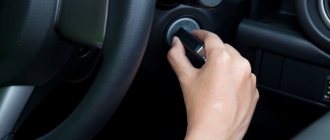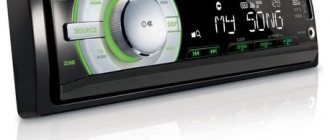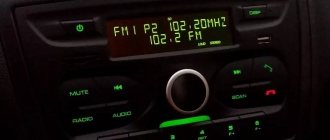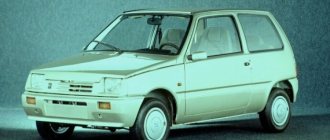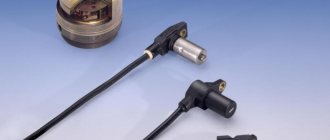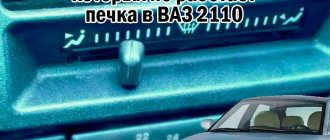Car radio with USB input
Most modern car radios have a USB input for reading audio files from a flash drive. This method of storing and reproducing audio information is more reliable, noise-resistant, informative and convenient from a consumer point of view than CDs and DVDs.
Many manufacturers are gradually abandoning disk drives in favor of USB and other electronic storage media.
However, the playback method via a USB port has one fundamental drawback: some flash drives and various car radios refuse to be read. Moreover, a situation very often occurs when one radio tape recorder reads the same flash drive without problems, but the other completely refuses to “see” it.
Formatting a flash drive
If the radio does not read files, but the information is read on the computer, first of all, using a PC, you need to check in what format the data is recorded. But in order not to be tormented for a long time by the question of why the working flash drive on the car radio cannot be read, the easiest way is to format the USB drive in the required format (FAT32) and record the material again, then check how the radio perceives the files. Formatting is done as follows:
- insert the flash disk into the USB socket;
- if the “Autorun” menu appears on the screen, close it and go to “My Computer”;
- we find a removable disk, in this case it is a flash drive if there are no other USB devices connected to the PC;
- when you left-click on “removable drive F:” (maybe a different letter), a pop-up menu appears; from the available options, select “Format”;
- if FAT is set in the “File system” line, change the format to FAT32. In the “Quick Format” menu, check the “Quick” checkbox, click the “Start” button, confirm “OK”.
It is important to remember that formatting completely erases all data, so if you need to save files recorded on a flash drive, you need to make a backup copy. As a rule, after such an operation, many USB drives begin to be read on the car radio, if, of course, the audio equipment itself is working properly.
Why doesn't the radio read the flash drive in the car?
The main reasons that the car radio does not see the USB flash drive are:
1. Lack of file system support for the car radio
, in which the flash drive is formatted.
Most car radios produced before 2010 support FAT32 USB file systems. If the radio is even older, then it can only support the FAT16 file system.
New car radios, especially standard ones, may have support for the NTFS file system, and if the media is formatted in FAT32, which is more “ancient” from their point of view, problems may arise when reading audio information.
If there is no reliable information on the radio (technical characteristics) about what file system the USB port driver supports, in many cases you have to sequentially reformat the flash drive to FAT32, then to NTFS, respectively, write test audio files to it.
This can only be done using a computer (laptop, netbook). To do this, right-click on a removable disk (flash drive) connected to the computer, select “formatting” in the context menu
and then the corresponding file system.
2. Inability to read audio files stored in folders with a complex hierarchy
. Car radios produced before 2000 and inexpensive FM transmitters suffer from this disease.
If the playlist has subfolders, for example, such as root directory - Russian songs - folk - babkina, then perhaps it will not be possible to enter some folders remote from the root directory.
Therefore, on radios made before 2000, it is better to record audio files in the root directory, especially since using a computer it is not difficult to create and rewrite any playlist.
3. Exceeding flash storage capacity requirements
. Over time, the capacity of USB storage devices is rapidly increasing. Flash drives up to 8 GB, as a rule, are read by all car radios. Regarding the installation of higher-capacity media, you should check how much capacity, inclusive, is supported by the radio installed in your car.
4. Incorrect (most likely Russified) names of audio files
and folders. At best, what most non-Russian radio tape recorders do is to write the names of audio files in the form of Russian hieroglyphs, at worst, they refuse to read them.
Video - why the flash drive does not work in the car and how to format it:
If folder names are written in Russian, access to these folders may be denied. In any case, if a non-Russian radio model is installed in the car, it is better to rename the files and folders to English characters when creating a playlist on a flash drive.
5. Inability to read audio files recorded in other formats
associated with the lack of appropriate codecs. Many audio files can have different origins: downloaded from the Internet, recorded from a DVD, sent by friends. Therefore, their formats may differ.
Each car radio has a set of codecs that determine the types of audio files that can be played. When buying a radio, you need to pay attention to this fact. As a rule, the standard set includes the most common mp3 and wav formats. Good radios support most known formats.
But, if you inherited an old radio tape recorder, and the recording has musical value, it can always be re-encoded using special converter programs on your computer.
6. Radio software crashes
, often found in multimedia complexes with an Internet connection in case of virus infection. Nowadays, it is not uncommon for even radios connected to the Internet to start mining. At the same time, its resources are limited to almost zero. Even the usual codecs are not fast enough, and the audio file slows down or does not play at all. The same effect can be obtained by catching some kind of virus, even from a music flash drive.
Advice: check flash drives for viruses (at least with a simple antivirus program) before installing it in the radio.
7. Technical difficulites
(damage to the USB connector, driver, problems with the power bus). Such problems often occur when they try to use the USB connector of the radio to charge car gadgets.
Remember: in most car radios, a USB connector is provided only for installing a working flash drive (unless an additional purpose is specified in the technical specifications of the radio).
8. In car radios (or flash drives) of dubious origin there is another reason - “ for no reason at all.”
" Flash drives on which information is recorded in completely identical formats with the same file system and volume, one is readable, the other is not. In this case, you have to individually select flash drives for the radio, and nothing can be done.
Let's sum it up
If it happens that the radio in your car stops reading flash drives, it’s not a big deal. There are many options for fixing this problem. Just read the three main directions in troubleshooting and start with the simplest thing - formatting a flash drive. If this does not help, you should check all visible connections of the radio, and also take into account the type of its behavior when connecting a flash drive. Then you can update the firmware of the device itself, which is also done quite simply if you have the factory instructions.
Otherwise, you will have to contact a service center to repair the hardware of the radio. This option promises you certain expenses for the services of specialists. It’s quite easy to get the necessary capabilities and return the radio to working order. If, after performing all the stated procedures, the problem remains, the radio will have to be replaced. However, for cars with a stationary music system this will be an incredibly difficult and expensive process, so you need to try and restore the music equipment. Have you ever had problems with radios and flash drives?
How to decipher the error code and fix it
Some “smart” car radios report information on the display that they specifically do not like about the USB storage device.
For example, these error codes:
- ERROR 23 – FAT32 or NTFS file system mismatch;
- ERROR-PROTECT – absence of Windows Media codec in the radio;
- CHECK USB – USB port power supply error;
- ERROR 19 – Cyrillic in file names, complex hierarchy, lack of an appropriate codec, etc.
For other types and error codes, please refer to the owner's manual for your specific brand of car stereo.
What to check first:
- The first thing you need to do is check whether the information from the flash drive is readable on another device - another radio, computer, laptop, etc. If the computer does not see it, then the problem is clearly not in the car's stereo.
- Check the socket - USB input where the data drive is inserted. This can be done by inserting other flash devices. If the stereo system does not read these devices, then there may be a bad contact in the connector itself, but if the information is read, then the problem is probably not a broken connector.
In the case where these mechanical damages are absent, it is worth paying attention to some other aspects.
Flash drive malfunctions
It often happens that the flash drive itself is faulty, and it is not recognized as a device not only on the radio, but also on the computer, in which case it is better not to try to restore it, it is more advisable to replace it with a new USB drive. The most common causes of flash-USB failure:
- mechanical impact, although the flash drive often works even with a broken case;
- water ingress - if moisture gets into the removable disk housing, it is better not to connect the device anywhere, first try to dry the board;
- natural aging - there are no eternal devices, sooner or later any equipment breaks down.
If the radio is not capable of playing audio files due to the large memory capacity of the flash drive, there is hardly anything that can be done; it is easier to buy a smaller capacity USB drive for use in the car.
Existing formats for radio tape recorders
There are many formats (so-called sizes, further in the text), some are more in demand today and are used in a wide range of models, others are less common, either outdated or too new:
- The most famous audio sizes are MP3, WAV, WMA, CDA
- MP3 is today the most popular and most licensed format for storing audio data, which was developed by a group of MPEG campaign specialists
- In this size, a new algorithm for encoding information with losses in the upper and lower frequencies of sound is used
Note: There are no such losses in the CDA format.
- But the technology allows you to significantly (10 or even more times) reduce the size of an MP3 file in comparison with the original CDA format
- Moreover, the average bitrate of a compressed file is more than 128 kbps
- And the higher the speed of information transmission, the better the quality of the resulting music file is reproduced
- However, due to the use of the perceptual encoding method, the deterioration in quality during playback remains practically unnoticeable to the average listener
Note: You can only notice the difference if you have a good radio and excellent branded headphones, which 90 percent of ordinary listeners do not have.
- CDA has been used for a long time on CDs, it is the very first and simplest for storing digital audio data. File playback occurs at a certain fixed disk rotation speed and has the highest playback quality, this is explained simply, data in the CDA format is not compressed, don't give in to him
- WAV is the closest size to CDA in terms of its internal content
- The format is “outdated”, so it is rarely supported by modern car radios
- It has a rather low quality of reproduced sound and a large file size
- WMA is a format developed by Microsoft Corporation and is used for playing and storing audio data.
- In fact, it is an alternative size to MP3
- A distinctive feature from other audio sizes is the highest encoding rates (compression and surround sound and voice), this allows you to get files of a fairly small size
- The format uses the Lossless method, which allows you to maintain the quality of all encoded data
- The disadvantage is the low threshold of its sensitivity to errors
- If data is damaged, then it will be impossible to reproduce it not only in the area of damage, but also 5-10 seconds before the damage and the same amount after that
- AAC - some car radios today support this format, the m4a file extension (meaning a file without any protection)
- The main feature is the lower quality loss that occurs during compression compared to similar MP3 sizes
- It is used much less frequently than other similar formats (like MP3, WMA)
- There are a number of formats that are practically not supported by car radios.
- These are outdated formats for lossless information compression - WV, ALAC, MLP, Monkey`s Audio APE, TTA
- They occupy large amounts of data and are used in acoustic systems of recording studios, in high-quality sound reproduction equipment and specific sound devices.
- The only exception to the rule is the FLAC size.
- At the moment, this is one of the audio codecs still supported in car radios that uses the Lossless recording method.
- A distinctive characteristic from similar formats is that information from the audio stream is not deleted and remains in its original form after it is compressed.
Today, disc car radios usually support all the classic sizes for video playback:
- Video format for car radios - VCD, DVD, and SVCD
- Used to store video with sound
- All of these formats have some limitations when choosing the size and proportions of the image that is encoded in them
- The most popular video format, which is used in DVD car radios (see DVD car radios with a screen and their review), is MPEG4 (with Xv codecs >
